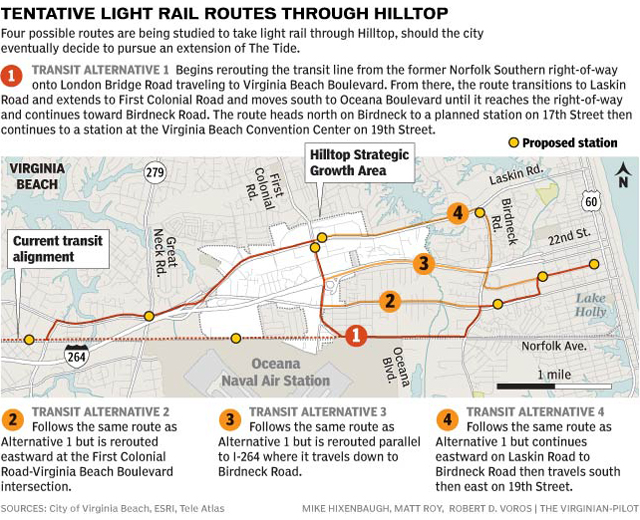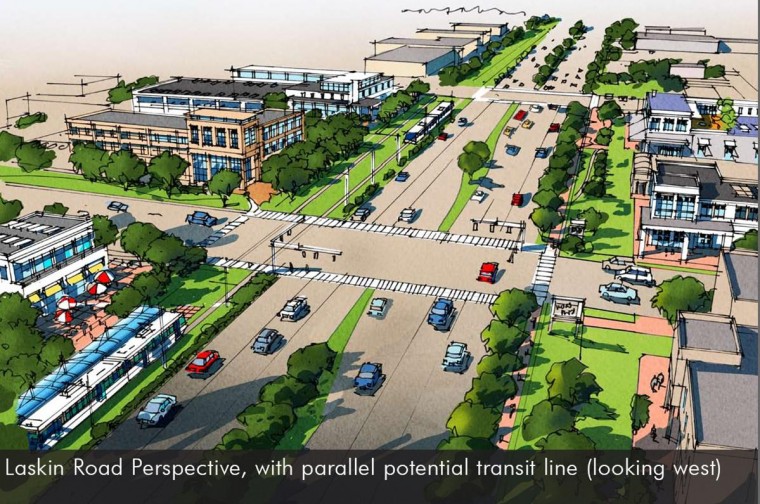You are currently browsing all posts tagged with 'Light Rail'.
The alternative to extending Light Rail now is a Grim Tale
posted on Wednesday, November 13th, 2013 at 4:28 pmLight Rail “nay sayers” have a view of the future that our choice is between (1) more and wider roads, or (2) a fixed rail link between regional communities that is likely to run in the red for the near term.
Choice (1) is folly since building roads destroys the environment and fossil fuels will inevitably run out for our private cars to drive on them. More roads also spreads out the population settlement pattern that in turn requires even more roads, greater destruction of the environment, more pollution and further commuting congestion and community separation.
Choice (2) will run in the red until settlement patterns catch up with the regional vision of the future. Light rail is expensive and requires investment at the earliest opportunity for a sustainable future.
I was charmed with the photo of the front page of the Hampton Roads section of the Virginian Pilot this morning. Imagine, three private proposals for extending the TIDE light rail from Norfolk into Virginia Beach. What a bright future there could be in the future of Hampton Roads.
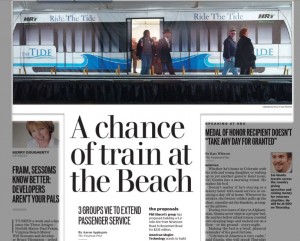
The reason that the smaller metropolitan area of Charlotte, NC already has light rail serving its commuter population could be because the political leadership there is operating with a vision of itself as a cohesive regional economy, rather than a balkanized satellite cities competing for a separate piece of action.
It seems to me there are regional transportation investments that could make a huge difference in the future growth of Hampton Roads towards becoming the regional economy that it deserves to be: (1) an expanded commuter Light Rail system, and (2) an expanded nationally focused airport with its own designated airline Hub.
Earlier this week Governor-Elect Terry McAuliffe included mention of his support for extending light rail to Virginia Beach: “One important issue that I did campaign on — it is time we took light rail all the way from our naval base all the way to Virginia Beach.”
It is worth a chuckle to see the photo of Kerry Dougherty, at the top of her column, overshadowed by the banner image of The TIDE rail car along with the headline: “A Chance of Train at the Beach.” As if to say, “Kerry, you missed the train,” with her non-supportive commentaries, completely misunderstanding the opportunity that light rail means for the region of Hampton Roads.
Tags: future, Hampton Roads, investment, Light Rail, region, The Tide, transportion, virginia beach
Light Rail and Wal-Mart are from different planets!
posted on Wednesday, June 19th, 2013 at 3:33 pmPlanning and academic research on the subject of property value changes due to the presence of a nearby Light Rail station consistently documents a positive investment opportunity, especially for commercial property and apartments.
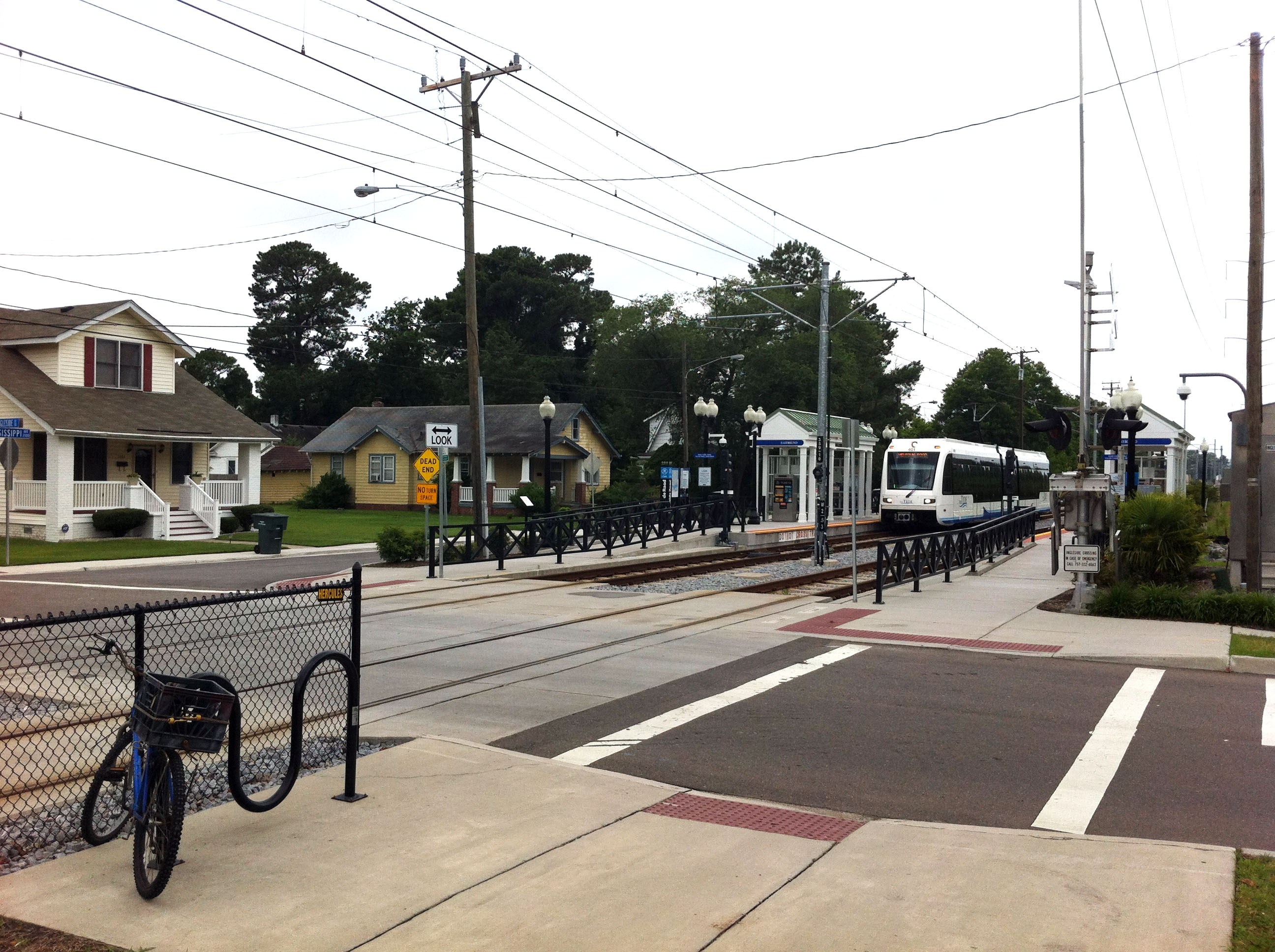
There was an article on the second page of the Virginia Pilot in the June 8th issue, relaying a story about a new Wal-Mart and Wawa coming to the intersection of Ingleside Road and Princess Anne Road in Norfolk. My first thought was, “Does this investment have anything to do with the proximity of the Ingleside Light Rail station for The Tide?”
The article compared the proposed Wal-Mart at Ingleside to a so-called “Neighborhood Market” on Holland Road in Virginia Beach. A typical Wal-Mart store does tend to look and operate like the Holland Road Marketplace. That project would be more aptly be described as an “Un-neighborly Marketplace” since walking there from a nearby house or apartment is to be faced with traversing a wasteland of parking areas and driving aisles. I am open to the possibility that Wal-Mart and Light Rail could be designed to be mutually supportive but the comparison to the Holland Road Marketplace translates to more of the same.
City planners can sometimes influence the design of a large commercial project. They cannot however, transform the design from a big box store to become a truly pedestrian-friendly “Neighborhood Market” project. This project is likely to look and function like the Holland Road Marketplace to which the article writer refers. (That site was formerly a giant Super K-Mart that was closed a few years back.)
The proposed Wal-Mart project is not likely to be a positive influence on the surrounding neighborhood at Ingleside and Princess Anne roads, in terms of becoming a better place to live. There is already another Wal-Mart center about 3 miles away, next to the JANAF shopping center, whereas the proposed new location is 1.7 miles from the Ingleside Light Rail station. Sadly, there is no pedestrian linkage between the two. Distance is not the only obstacle to overcome for Ingleside Road to be imagined as a walking path to the new Wal-Mart, since there is also Norfolk Industrial park that lies along the route.
I believe the presence of light rail is the single most direct opportunity to influence proper urban patterns into the future. As gasoline prices climb upward to the level that they are in Europe already ($12 per gallon) development choices are going to need to be made that do not depend on the private automobile to the extent that has been during the 20th century. We can begin now to make development choices that will shape our urban environments to function more like European cities. Pick your favorite European city and notice how important fixed route public transportation is to the pleasure of the place.

Weighing the pluses and minuses of this prospective Wal-Mart at Ingleside Road and Princess Anne Road, I can see that the new Wal-Mart is good for the tax base of the City of Norfolk, and would provide some new jobs in the area. Another plus is that this Wal-MartCenter has two HRT bus routes within a half mile radius.
By having these bus routes close to the Wal-Mart, they make this proposed site an infill property that is well integrated into the fabric of the existing public transportation systems. Even if the City Planners succeeded in helping the new Wal-Mart appear to be a pedestrian destination instead of another automobile oasis, it is not walkable to the surrounding residents.
I would like to see the stops for The Tide light rail surrounded by small retail establishments that can service the commuters. When stations provide parking spaces for commuters, retail businesses see advantages in locating to those areas. A treed park could pop into the picture, and pretty soon nearby residents would go to those areas for reasons other than to board the light rail. The criteria for selecting stops for new light rail routes should strongly take into consideration intersections where there is already some element of pedestrian activity. The Wal-Mart at Ingleside and Princess Anne Road will do nothing positive for its surrounding neighborhoods. Neither does it contribute to stimulate any pedestrian dynamics for the light rail station at Ingleside Road.
The presence of the Tide light rail station stop at Ingleside Road and the proposed Wal-Mart at Ingleside are too far apart to have a pedestrian relationship, too economically detached have common goals for the surrounding neighborhoods. It’s more like they come from different planets and chanced to land on the same road.
Tags: Hampton Roads Transit, Holland Road, HRT, Ingleside Road, Kroger Marketplace, Light Rail, new urbanism, Norfolk, pedestrian, public transportation, sustainability, The Tide, VA, Virginia, virginia beach, Wal-Mart, walkable
PROVIDE LIGHT RAIL TO PORTSMOUTH INSTEAD OF MIDTOWN TUNNEL
posted on Wednesday, July 18th, 2012 at 3:58 pmThe recent editorial in the Virginian Pilot is in favor of the campaign to squash plans for the construction of the Midtown Tunnel. Agreed. The extension of The TIDE Light Rail to Portsmouth is the better alternative. How fortuitous that the tunnel project could be declared unconstitutional. There are plenty of common sense reasons to scuttle spending $2.1 billion for a “cars only” tunnel and its endless tolls.
The affect of the tolls on the commuters of Portsmouth would severely upset the vision of regionalism in Hampton Roads. The toll would hurt business growth in Portsmouth. Neighbor-city residents will be discouraged from going to Portsmouth for shopping, sight seeing, restaurants, ntelos venues, museums, the list goes on. Imagine how the tolls will affect real estate values in Portsmouth?
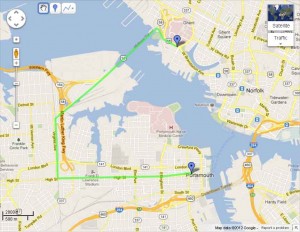 ATTENTION VDT! One way to reduce traffic on the existing midtown tunnel would be simply to introduce the tolls without the expansion. The capital cost will be zero where the effect the same. And what will happen to all the traffic during construction? Won’t it get severely worse? Is the expansion of the tunnel as a remedy for improving commuter time worse than the problem itself? The idea of the expanded tunnel is great for more cars but fraught with side effects: worse pollution, greater fossil fuel consumption, increased noise, additional storm water flooding.
ATTENTION VDT! One way to reduce traffic on the existing midtown tunnel would be simply to introduce the tolls without the expansion. The capital cost will be zero where the effect the same. And what will happen to all the traffic during construction? Won’t it get severely worse? Is the expansion of the tunnel as a remedy for improving commuter time worse than the problem itself? The idea of the expanded tunnel is great for more cars but fraught with side effects: worse pollution, greater fossil fuel consumption, increased noise, additional storm water flooding.
As an architect I am schooled in the notion of designing for a vision of the future in terms of lasting for at least a century. It is the “greenest” thing I can do to create a project that is not torn down and replaced before the mortgage is paid off. Site plans are cognizant of the 100-year flood plane as an important design criteria. Shouldn’t transportation systems be held up to the same time horizon? Isn’t fossil fuel depletion, pollution, and land economics setting a stage for an urban development pattern that favors people ahead of providing for ever greater numbers of cars?
 Could it be that in 100 years (maybe longer) the expansion of the Midtown Tunnel would look like a bridge to nowhere? There is better idea. Enter the TIDE, here to save the day, with a rolling cape, snappy logo and the ability to vanquish the most powerful villains. Super TIDE has arrived. Our posted map shows that the travel distance to downtown Portsmouth is less than six miles from EVMC (Eastern Virginia Medical Center), the current last stop of the exiting light rail (including the length of the tunnel itself).
Could it be that in 100 years (maybe longer) the expansion of the Midtown Tunnel would look like a bridge to nowhere? There is better idea. Enter the TIDE, here to save the day, with a rolling cape, snappy logo and the ability to vanquish the most powerful villains. Super TIDE has arrived. Our posted map shows that the travel distance to downtown Portsmouth is less than six miles from EVMC (Eastern Virginia Medical Center), the current last stop of the exiting light rail (including the length of the tunnel itself).
We already know that the cost of construction for a light rail tunnel is “considerably less” than the “cars only” tunnel expansion project as currently proposed. It is reasonable to imagine that the cost of providing a new train tunnel as well as extending The TIDE all the way to downtown Portsmouth may be no more expensive than the Midtown Tunnel project with none of the negative side effects.
Light rail promotes urban development patterns that have long term future benefits, providing the millennium planning view for Hampton Roads. Hamilton, Ontario, is an example of a city where citizens have taken a stand for their city’s potential in becoming a more vibrant, livable, and attractive place to live and work. Eight positive reasons in favor of light rail are listed on its website. The extension of the TIDE to Virginia Beach is great. Its time to call in Super TIDE to save the day in Portsmouth too.
Tags: Light Rail, Portsmouth, regional, The Tide, tolls, tunnel
Selecting an established commercial hub is a prime Light Rail station stop
posted on Saturday, June 2nd, 2012 at 8:27 pmThe idea of diverting the LR route from the rail Right of Way to the service access roads at Hilltop came from a resident participant at the Strategic Growth Area public forum. That was only last month. The consultant has already offered alternate routes, how responsive is that? Bravo!
The best thing about the extension of light rail to the Virginia Beach resort area is the development patterns that will be anchored at the selected station stops. To quote an article regarding the settlement pattern improvements resulting from the introduction of the new Metro Light Rail in Phoenix: “…they (station stops) draw development around them and with it people, density, culture and business vibrancy …a place where local color develops and evolves at a greater speed and depth than sleeper communities.”
It seems to me that the benefits of improving neighborhood places (insert Hilltop) to become more “centralized, sustainable, and walkable” is accelerated by choosing it as a light rail station stop. If there is a flaw with the vision of The Tide in Norfolk it is that the choice of station stops outside of the CBD. They are “sleepers”. The neighborhood development opportunities at Newtown Road, for example, are enormous and there is nothing there yet.
I continue to be frustrated with the banter that gets published in the newspaper that reduces the discussion of the extension of light rail to Virginia Beach as a matter of public investment accounting. Pubic policy makers (federal, state and local) are currently accustomed to making decisions to subsidize highways almost exclusively. Those expenditure decisions benefit oil companies, automobile makers, and tunnel contractors, as we are painfully aware. What about us? the citizens of Hampton Roads. What do we want?
I am grateful that we will get our day in the voting booth to voice our choice for an alternative to the proliferation of everything associated with dependence on the private automobile as our only means of transportation. I believe that the citizen’s perspective of the best alternatives for transportation investment in the future is more far-sighted than the transportation establishment. The current policy makers view has resulted in funding a 2.1 billion dollar midtown tunnel project. A better choice would have been to extend a light rail tube into Portsmouth.
Budgeting our precious public funds to extend highways and enlarge tunnels results in more roadways that inevitably become clogged with ever greater numbers of automobiles (contributing to air pollution, traffic congestion, accidents and lost time commuting). These expenditures consume vast amounts of vacant land for more and wider roads, thereby creating the need for further expenditures of tax monies to handle storm water runoff, landscape maintenance and noise separation barriers.
The choice for highway investment promotes wasteful low-density residential developments of architectural monotony, encouraging “look alike” subdivisions of single-family units separated by individual driveways with cars parked in front yards.
The choice for highway investment promotes an automobile oriented shopping centers surrounded by acres and acres of pavement that require a car to reach. It is reported that the capital cost to the local government of a parking space at a shopping center is currently $8,000. What is the public value of that expense?
Light rail is the logical alternative to exclusive investment in providing for the private automobile. It is almost like a prophesy for the future of Hampton Roads that the citizens should be the voice of vision that gives it life.
Tags: Hampton Roads, Hampton Roads Transit, Hilltop, HRT, Light Rail, Light Rail Extension, Metro Light Rail, Phoenix, public transportation, virginia beach
Midtown Tunnel design missed Light Rail completely
posted on Sunday, April 29th, 2012 at 3:20 pm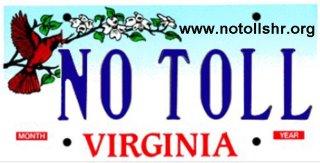 There is political momentum and apparently popular enthusiasm in the press for extending the Tide light rail to the resort area of Virginia Beach. I am anxious to vote my support for that project. I consider the light rail proponents to be cultural visionaries for the future of the whole of Hampton Roads.
There is political momentum and apparently popular enthusiasm in the press for extending the Tide light rail to the resort area of Virginia Beach. I am anxious to vote my support for that project. I consider the light rail proponents to be cultural visionaries for the future of the whole of Hampton Roads.
It takes a somewhat bigger view of the future to see the broad opportunities that light rail could have in the future of Hampton Roads, beyond the extension to the Beach. The bigger view was brought home to me upon attending an event sponsored by DBIA, Hampton Roads chapter of the Design Build Institute of America. The March 2012 presentation was conducted by the engineers responsible for the construction design of the new Midtown Tunnel.
The technical engineering expertise provided in the presentation was brilliant, but there is a doubt about this project that pervades anytime the project is mentioned, regardless of the circle. The voices of municipal leadership when speaking about the pending imposition of tolls is with gritted teeth, “we have to accept it.” No one can recall how public comment was invited into the deliberation of the merits of this project, certainly not Portsmouth citizens: Would you like another midtown tunnel? …by the way it will come with a nearly $2 toll each way.
The future impact of this project is clouded. The EZpass toll collection mechanism is fraught with problems. As soon as the tunnel starts collecting the toll local drivers will avoid using it. The statistical overcrowded volume of traffic will suddenly be diminished. The cityscape of Portsmouth will be irreparably desecrated by the flyovers and ramp exchanges to reach 264. Portsmouth will be orphaned economically for the foreseeable future, perhaps until the VDOT decision makers initiate tolling all the bridges and byways to mitigate the isolation of Portsmouth.
There is a better idea to solve this dilemma, compelling logic of a different course of action, other than a new Midtown tunnel, that would strengthen the cultural integration of the region and at the same time relieve the traffic congestion in the existing midtown tunnel. The DBIA event of last month was concluded by questions from an audience of more than a hundred planners, architects, engineers and interested professionals. The last question of the presentation was: Did you consider adding a light rail line to fit into the new tunnel tube?
The speaker casually offered a solution to the omission of a light rail line in their midtown tunnel design by saying that it could easily be added at a later time, by a different kind of tube, at much less cost than trying to include it within the concrete tube that had been designed and funded. The profound dichotomy of this response may be the answer to the midtown tunnel dilemma. I propose that tax funds earmarked for the construction of the new concrete tunnel should be diverted to the “much less expensive” project adding a steel tube tunnel to extend light rail across the channel to Portsmouth. (The Tide currently ends a few thousand feet from the existing midtown tunnel entrance.)
I admit endorsement of light rail to Portsmouth takes some ponderous extrapolation of current passenger data to be a believer. (Virginia Beach is taking three years for a third party study to justify its extension.) For now, consider the intuitive logic of how light rail builds community neighborhood nodes at the station stops. The beauty and cultural vibrancy of an existing urban environment such as Portsmouth is renewed and reinforced by the architectural identity of becoming a destination place for light rail.
Consider the effect of what happens as the price of gasoline climbs steeper and steeper. Vehicle miles traveled are already plummeting. Independent economic choices are being made daily, toward more fuel efficient cars, combining trip purposes, and car pooling. Project our $4 per gallon gasoline to $12 per gallon (the current price of gasoline in Copenhagen) and what happens? Light rail and buses and bicycles become important alternatives to driving the household car. The midtown tunnel project should be evaluated in a 100-year time horizon for its cultural impact, just as we commonly do for designing for a 100-year flood plane for public safety.
As one focuses on a picture a future with much less car driving we begin to see changing urban settlement patterns toward higher density urban living (more dwelling units per acre) where lifestyles move toward neighborhood walking to shop, for entertainment, to recreate and to use public transportation. Fixed transit routes such as light rail are the preferred means of mass transportation. This future vision is much healthier since we walk more regularly, the air is cleaner, and it is also much friendlier since we are interacting with other passersby at closer proximity on a daily basis.
When you can find this vision of the future an attractive alternative to making greater and greater capital improvement investment in accommodating the almighty automobile there is wisdom in scrapping the midtown tunnel project and swiftly switching our precious public funds into a much cheaper light rail tube across the midtown channel. All of the horrible unfairness of the tolls is eliminated. Vehicle traffic in the existing tunnel will diminish. The goals of regional integration of the separate municipal boundaries become less distinct.
I don’t want to imply that the Midtown extension of the light rail should take precedence over the project of bringing it to the resort area of Virginia Beach. We want both extensions. In fact, if the pot of gold that is available to pay for the new midtown tunnel was directly transferrable to pay for our light rail improvements it appears that there would be enough money to cover both extension projects.
Can we abandon the new Midtown Tunnel project at this point in time? The answer is: YES, of course. Engineers and architects do occasionally work on projects that are never built. Owners and end users do change their minds about following through with a design. The engineers get paid for their efforts and life goes on, hopefully for the better. There is a provision in the Midtown contract agreement that spells out the procedure for project termination.
This last minute rethinking is not really the last minute but it is an opportune decision point. Among the objectives spelled out in the DESIGN-BUILD CONTRACT with Skanska (SKW Contractors), December 5, 2011, the Midtown Tunnel project was supposed to: Increase transit service between Portsmouth and Norfolk. This exact language was spelled out in the agreement under the heading KEY COMPONENTS OF THE PROJECT. Needless to say the project we are getting fails categorically on this component. There is still time to save the day.
PS – I wrote this article a month ago and sent it to Virginian Pilot “letters to the editor”.
Tags: Hampton Roads, Light Rail, Midtown Tunnel, new urbanism, notollshr, Portsmouth
Virginia Beach City Council voted in favor of a public referendum for Light Rail
posted on Tuesday, April 24th, 2012 at 6:13 pmThis is a big step forward since there was a previous referendum in 1999 that was voted down. I was among the testifiers at the council hearing vote the night of April 24, 2012. There were speakers for and against at the hearing. A primary theme of the nay sayers was that they wanted to delay the referendum until after a feasibility study was completed toward the end of 2012. Some of my remarks follow:
All the while I have pursued my livelihood as an architect I have continued to see myself as something of a city planning thinker. The principle of NEW URBANISM is what I stand for and why I speak for what I believe is the single most important regional opportunity for the future of New Urbanism in Hampton Roads, extending the Tide Light Rail into Virginia Beach.
The opportunity is about what and where to spend public funds for transportation improvements: ROADS ONLY or LIGHT RAIL as well as ROADS
As I see it – We could continue to spend tax revenue exclusively on improving roads and highways….
We could continue
extending highways and enlarging tunnels that inevitably become clogged with ever greater numbers of automobiles (contributing to air pollution, traffic accidents and lost time commuting)
We could continue
consuming vast amounts of vacant land for more and wider roads, thereby creating the need for further expenditures of tax monies to handle storm water runoff, landscape maintenance and noise separation barriers
We could continue
promoting low-density residential developments of architectural monotony, encouraging “look alike” subdivisions of single-family units separated by individual driveways with cars parked in front yards
We can continue
developing automobile oriented shopping centers surrounded by acres and acres of pavement that require a car to reach
I believe the public knows better than many transportation planning administrators and industry stockholders that would have us spend all our transportation tax monies on subsidizing the future dependence on the automobile. I believe it is folly to imagine a future that can sustain ever greater numbers of automobiles and the availability of an unlimited supply of fossil fuels to operate them.
I believe the citizens of Virginia Beach are anxious to vote for a chance to have a choice in future for Light Rail as an alternative to automobileland.
Tags: extension, Light Rail, public transportation, The Tide, transit, virginia beach
Light Rail extension into Virginia Beach, sooner, rather than later
posted on Sunday, February 5th, 2012 at 9:51 pmDoes a proper vision of the future form of Hampton Roads include light rail transit? The question is more controversial than I imagined, most recently triggered by the story in the Virginia Pilot that there could be a referendum in November for the extension of the Tide into Virginia Beach. As of this writing, there is posted nearly 300 reader comments in response to the article written one week ago. The article included some of the political “weighing in” of local elected officials.
My own attitude starts with the notion that the actions to be taken should be directed at maintaining and improving the region as a healthy place to live, recreate, earn a living, enjoying the beauty of the surroundings and preserving it for future generations. (Insert the name of your home place, there should be no disagreement.) Does that vision include light rail transit? I think it does. Here are some reasons that creating a referendum in November are timely opportunity to take:
1. The Tide has demonstrated a measure of success but it is incomplete until it is extended to include linking with a larger geographic area and the other cities of Hampton Roads. (The future of the automobile as the only mode of transportation for creating settlement patterns of the best urban places possible is changing.) The longer the extension of the Tide is put off the greater will be the delay in realizing the best vision of the future of this place, Hampton Roads.
2. There is a financial opportunity to make the extension to Virginia Beach in a not-too-distant future by virtue of the federal funding that is available. It is the best priority to follow, as a practical matter, since it will take decades for the full realization of the light rail network that is desirable in the “best future” vision.
3. A six-million dollar study is underway, purportedly to recommend the most practical form for the future of public transit in Hampton Roads. (There is no doubt that an increased interest in public transit in the future of this region is coming. That is a sure bet. What form it takes, buses or rapid transit or light rail, will shape the future development patterns for the better or worse.) Is it necessary to have a high-powered study completed to have an opinion on a vision of the future? Is the price tag really that much in doubt? Is the allocation of funds to create this transportation improvement that much different than making new roads or bridges to subsidize our dependence on the automobile?
4. Doing nothing, postponing or avoiding taking a stand on how to improve public transit into the best vision of the future for Hampton Roads, is irresponsible. Since a referendum would be necessary at the completion of the study that could delay the time it takes to get the light rail option started and jeopardize the availability of federal funds, not to mention the increased capital expenditures due to rising construction costs.
5. Critics of the extension project have cited the crime problems of the Baltimore Light Rail Station in Linthicum as an inherent objection to light rail. But that is an irrelevant distraction to the opportunities at hand with the extension of the Tide into Virginia Beach. Neighborhoods are not all the same. Presumably spending 6 million dollars on a study provides some insight into recommendations for station location, physical design and security considerations. Linthicum is not Bird Neck Road, that would be the last station on the extension corridor under consideration.
6. Lest it be forgotten, Virginia Beach already owns the existing Norfolk Southern right of way from Newtown Road to Bird Neck Road. That purchase was settled in September 2010. Council members voted unanimously to close the deal. It was a year earlier that the city purchased the former Circuit City property next to Town Center for a future location of a Light Rail Station. At that time the mayor promised a public referendum on the extension of the Tide, upon the conclusion of the transit feasibility study. Adjusting the timing of that referendum, in consideration of the funding sources available, is being a prudent consumer as opposed to a public manipulator.
I am excited about re-shaping neighborhood development patterns that would be driven by the introduction of light rail stations as a result of the extension of the Tide into Virginia Beach. (Extending rubber tire bus routes will not produce the same development opportunities for community place identification.) Yes, some real estate investors will make more than their share of opportunistic wind falls or more modest up ticks. If the vision of the future is for a Hampton Roads to be composed of urban community enclaves with denser development patterns, centralized, walkable, integrated communities and composed of buildings architecturally sustainable and diverse – I say, the sooner the better.
Tags: Hampton Roads, HRT, Light Rail, Neighborhood, referendum, retail development, stations, The Tide
Top Ten Reasons to celebrate the Tide
posted on Friday, September 2nd, 2011 at 8:05 pmI am kicking off my new blog on the inaugural week of the light rail in Norfolk, Virginia, an appropriate beginning to my “what say you” that is directed at urban planning issues especially as concerns designing houses and residential neighborhood communities, focused on the creation and preservation of what Steve Mouzon www.mouzon.com refers to as our “most loved places.”
Join in the excitement about Light Rail public transit in Hampton Roads, Virginia. Move over David Letterman, here are the top ten reasons to celebrate the Tide:
- 10. The cost of the Tide came in about the same as Light Rail in Houston that has a population 10 times as great, at about the same cost per mile. Hooray for tiny Norfolk!
- 9. The inaugural free ridership days (August 19-21, 2012) were extended for an additional a full week due to the popularity that was exhibited on opening day.
- 8. Even Norfolk natives are blown away by the visual connections that have transformed 7.4 miles of electric train into the golden strip urban of street life.
- 7. Economic incentives for businesses to locate near the light rail should increase the investment in residential neighborhoods, stimulate local-owner businesses and create pedestrian retail shopping communities.
- 6. Passengers can bring their bicycles on the Tide; there are wall brackets in the cars to hang one by folding back a pair of seats. Someday maybe there will be urban bikes in Norfolk.
- 5. It is a joy to ride the Tide to a baseball game at Harbor Park and avoid the parking lot mania before and after a game. Attendance is already jumped a notch since the Tide is running.
- 4. For a senior (over 60) going to a movie at Macarthur Center from Newtown Road will cost less for the ride than parking at MacArthur Center (not to mention saving the gasoline to drive there).
- 3. If jogging is your fancy, run around the beautiful Hague in Norfolk, park for free 7 miles away at Newtown Road station, enjoy an air conditioned recovery ride back to your car.
- 2. A great idea to visit downtown decorations at Christmas is to get a day pass on the Tide that also gives you a ticket for the Paddlewheel ferry from Waterside to High Street in Portsmouth and back. Enjoy the former Coleman Nursery Winter Wonderland in Olde Towne. Winter Wonderland in Olde Towne
- 1. Norfolk has pulled it off! Every year the extension of the Tide to Virginia Beach Resort strip is delayed will cost an additional $105,000,000 .…with an inflation rate on capital investment dollars for light rail transit tracking at 13 % annually. The extension estimate is currently reported at $807,000,000 (The Virginian-Pilot, April 9, 2011).
Tags: commuter, convenience, extension, Hampton Roads Transit, HRT, Light Rail, Norfolk, planning, Public Transit, The Tide, Town Center, traffic, transportation

